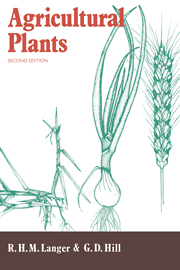Book contents
- Frontmatter
- Contents
- Preface to the first edition
- Preface to the second edition
- 1 World population and crop production
- 2 Plant structure
- 3 Liliaceae
- 4 Poaceae
- 5 Apiaceae
- 6 Asteraceae
- 7 Brassicaceae
- 8 Cannabinaceae
- 9 Chenopodiaceae
- 10 Cucurbitaceae
- 11 Fabaceae
- 12 Lamiaceae
- 13 Linaceae
- 14 Malvaceae
- 15 Papaveraceae
- 16 Solanaceae
- 17 Physiological basis of yield
- Index of specific names
- Subject index
16 - Solanaceae
Published online by Cambridge University Press: 05 June 2012
- Frontmatter
- Contents
- Preface to the first edition
- Preface to the second edition
- 1 World population and crop production
- 2 Plant structure
- 3 Liliaceae
- 4 Poaceae
- 5 Apiaceae
- 6 Asteraceae
- 7 Brassicaceae
- 8 Cannabinaceae
- 9 Chenopodiaceae
- 10 Cucurbitaceae
- 11 Fabaceae
- 12 Lamiaceae
- 13 Linaceae
- 14 Malvaceae
- 15 Papaveraceae
- 16 Solanaceae
- 17 Physiological basis of yield
- Index of specific names
- Subject index
Summary
The family Solanaceae is mainly of New World origin and, although without a doubt members of the family were used by the natives of the region before the arrival of the Europeans in America, the recorded history of economic members of the family seems to date from the discovery of the Americas by Columbus in 1492. Although there are about 75 genera and over 2000 species within the family very few are of economic importance. The major food crop is the potato (Solarium tuberosum) which is second after the cereals in tonnage of crop harvested in the world. In terms of economic importance next would come tobacco (Nicotiana tabacum). The long recognised habit-forming nature of smoking the leaf of this plant has provided governments throughout the world with a major source of revenue since James I of England tried to discourage the habit by setting a high duty on its importation. A further crop of both horticultural and agricultural importance in the family is the tomato (Lycopersicon esculentum) which, although extensively cultivated as a salad vegetable, is also grown on extensive areas for the production of soup, juice, sauces, tomato concentrate and canned tomatoes. Finally the chillies (Capsicum annuum and C. frutescens) provide the heat for the curries of Asia as well as being an important source of vitamin C as the raw vegetable.
- Type
- Chapter
- Information
- Agricultural Plants , pp. 308 - 327Publisher: Cambridge University PressPrint publication year: 1991
- 1
- Cited by



